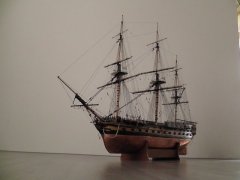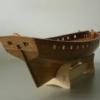-
Posts
2,305 -
Joined
-
Last visited
Reputation Activity
-
 NMBROOK reacted to gjdale in MORDAUNT 1681 by NMBROOK - Euromodel - 1:60 - Beyond Bashed
NMBROOK reacted to gjdale in MORDAUNT 1681 by NMBROOK - Euromodel - 1:60 - Beyond Bashed
Nicely done Nigel and kudos for your perseverance!
-
 NMBROOK reacted to Beef Wellington in MORDAUNT 1681 by NMBROOK - Euromodel - 1:60 - Beyond Bashed
NMBROOK reacted to Beef Wellington in MORDAUNT 1681 by NMBROOK - Euromodel - 1:60 - Beyond Bashed
Wow, very nice gratings Nigel! Envious
-
 NMBROOK got a reaction from tarbrush in MORDAUNT 1681 by NMBROOK - Euromodel - 1:60 - Beyond Bashed
NMBROOK got a reaction from tarbrush in MORDAUNT 1681 by NMBROOK - Euromodel - 1:60 - Beyond Bashed
Gratings Mk 4 part 2
1.5mm wide battens were glued into the grouves and allowed to dry.I used alaphatic applied with a cocktail stick and excess was vigilently removed with a wet brush.When dry,the back was sanded off and the battens flushed off.I used a small disc in the Proxxon IBE to do this.Before final trimming and profiling I am going to apply two coats of heavily thinned matt poly to prevent any splintering.Mr Frolich does mention this in his book and seems like a good insurance policy.
Kind Regards
Nigel
-
 NMBROOK got a reaction from tarbrush in MORDAUNT 1681 by NMBROOK - Euromodel - 1:60 - Beyond Bashed
NMBROOK got a reaction from tarbrush in MORDAUNT 1681 by NMBROOK - Euromodel - 1:60 - Beyond Bashed
Ok then,hopefully a more positive post.After trying the table saw route and more failures(the little nibs kept breaking of)I think I have it sussed.When in doubt,consult a book.After studying Frolich's method,it made a lot of sense when working with the problematic pear.Just a couple of tweaks to use the mill instead of a tablesaw.
So here we have Gratings mark 4?Part one.
A solid block 6mm thick was machined to follow the same pattern as what Frolich does.Basically the ledges are machined in the top face leaving some material acting as a backer holding them the correct distance apart.When the battens are glued and set,the rear face is sanded away leaving a complete grating.The important factor was the order of doing things to prevent the 'nibs' from being chipped.The block was placed in the mill so that the grain followed the ledges i.e.athwartships.1.5mm wide by 1.5mm deep grouves were then cut the right distance apart for the run of the battens.4mm deep by 1.5mm grouves were then machined perpendicular to these.These are the gaps between ledges.I have changed the gap despite what I said earlier to 1.5mm.This then matches the contemporary model,so should not look out of place.This process leaves the ledges attached to a backer which holds everything true while the battens are fitted.The fact that the final cut runs inline with the grain results in crisp 'nibs' with not chipping.I will take photos of the machining process for the next post,I didn't bother while making this until I was sure it would work
Kind Regards
Nigel
-
 NMBROOK got a reaction from gjdale in MORDAUNT 1681 by NMBROOK - Euromodel - 1:60 - Beyond Bashed
NMBROOK got a reaction from gjdale in MORDAUNT 1681 by NMBROOK - Euromodel - 1:60 - Beyond Bashed
Thank you Kevin I think the biggest lesson and reason I don't mind posting the bits that go wrong,is that no matter how long you have been doing this,things don't always go as planned
Kind Regards
Nigel
-
 NMBROOK got a reaction from md1400cs in MORDAUNT 1681 by NMBROOK - Euromodel - 1:60 - Beyond Bashed
NMBROOK got a reaction from md1400cs in MORDAUNT 1681 by NMBROOK - Euromodel - 1:60 - Beyond Bashed
Gratings Mk 4 part 2
1.5mm wide battens were glued into the grouves and allowed to dry.I used alaphatic applied with a cocktail stick and excess was vigilently removed with a wet brush.When dry,the back was sanded off and the battens flushed off.I used a small disc in the Proxxon IBE to do this.Before final trimming and profiling I am going to apply two coats of heavily thinned matt poly to prevent any splintering.Mr Frolich does mention this in his book and seems like a good insurance policy.
Kind Regards
Nigel
-
 NMBROOK got a reaction from Kevin in MORDAUNT 1681 by NMBROOK - Euromodel - 1:60 - Beyond Bashed
NMBROOK got a reaction from Kevin in MORDAUNT 1681 by NMBROOK - Euromodel - 1:60 - Beyond Bashed
Gratings Mk 4 part 2
1.5mm wide battens were glued into the grouves and allowed to dry.I used alaphatic applied with a cocktail stick and excess was vigilently removed with a wet brush.When dry,the back was sanded off and the battens flushed off.I used a small disc in the Proxxon IBE to do this.Before final trimming and profiling I am going to apply two coats of heavily thinned matt poly to prevent any splintering.Mr Frolich does mention this in his book and seems like a good insurance policy.
Kind Regards
Nigel
-
 NMBROOK got a reaction from Bill Hime in MORDAUNT 1681 by NMBROOK - Euromodel - 1:60 - Beyond Bashed
NMBROOK got a reaction from Bill Hime in MORDAUNT 1681 by NMBROOK - Euromodel - 1:60 - Beyond Bashed
Gratings Mk 4 part 2
1.5mm wide battens were glued into the grouves and allowed to dry.I used alaphatic applied with a cocktail stick and excess was vigilently removed with a wet brush.When dry,the back was sanded off and the battens flushed off.I used a small disc in the Proxxon IBE to do this.Before final trimming and profiling I am going to apply two coats of heavily thinned matt poly to prevent any splintering.Mr Frolich does mention this in his book and seems like a good insurance policy.
Kind Regards
Nigel
-
 NMBROOK got a reaction from Mirabell61 in MORDAUNT 1681 by NMBROOK - Euromodel - 1:60 - Beyond Bashed
NMBROOK got a reaction from Mirabell61 in MORDAUNT 1681 by NMBROOK - Euromodel - 1:60 - Beyond Bashed
Gratings Mk 4 part 2
1.5mm wide battens were glued into the grouves and allowed to dry.I used alaphatic applied with a cocktail stick and excess was vigilently removed with a wet brush.When dry,the back was sanded off and the battens flushed off.I used a small disc in the Proxxon IBE to do this.Before final trimming and profiling I am going to apply two coats of heavily thinned matt poly to prevent any splintering.Mr Frolich does mention this in his book and seems like a good insurance policy.
Kind Regards
Nigel
-
 NMBROOK got a reaction from md1400cs in MORDAUNT 1681 by NMBROOK - Euromodel - 1:60 - Beyond Bashed
NMBROOK got a reaction from md1400cs in MORDAUNT 1681 by NMBROOK - Euromodel - 1:60 - Beyond Bashed
Ok then,hopefully a more positive post.After trying the table saw route and more failures(the little nibs kept breaking of)I think I have it sussed.When in doubt,consult a book.After studying Frolich's method,it made a lot of sense when working with the problematic pear.Just a couple of tweaks to use the mill instead of a tablesaw.
So here we have Gratings mark 4?Part one.
A solid block 6mm thick was machined to follow the same pattern as what Frolich does.Basically the ledges are machined in the top face leaving some material acting as a backer holding them the correct distance apart.When the battens are glued and set,the rear face is sanded away leaving a complete grating.The important factor was the order of doing things to prevent the 'nibs' from being chipped.The block was placed in the mill so that the grain followed the ledges i.e.athwartships.1.5mm wide by 1.5mm deep grouves were then cut the right distance apart for the run of the battens.4mm deep by 1.5mm grouves were then machined perpendicular to these.These are the gaps between ledges.I have changed the gap despite what I said earlier to 1.5mm.This then matches the contemporary model,so should not look out of place.This process leaves the ledges attached to a backer which holds everything true while the battens are fitted.The fact that the final cut runs inline with the grain results in crisp 'nibs' with not chipping.I will take photos of the machining process for the next post,I didn't bother while making this until I was sure it would work
Kind Regards
Nigel
-
 NMBROOK reacted to JPett in HMS Victory by JPett - Corel - 1:98
NMBROOK reacted to JPett in HMS Victory by JPett - Corel - 1:98
Ahoy Mates
Thx for the likes and comments
Neptune: Welcome aboard; I see that you have build this kit. Your company and comments are most appreciated
Nigel: Thank you. I do agree that spiling would actually be much easier here but I have this whole OOB thing going on for this build. I am contemplating gluing two of the kit supplied pieces of planking together and then spiling that. On a side note I have just found the kit supplied wheel. That is going to be a big problem.
Mark: I am hell bent on correcting the kinkering and not sanding it out.
Sjors: Always a pleasure. I am a persistent "bass turd". That is my real strength. I am still working on the "skill" thing.
Back to the build
I am posting this for anyone who might be using my log as some sort of reference for their build.
There seems to be a point where the planks need to transition around what I would call the hip of the stern. (We could talk jeans here). I am getting a lot of kinkering: More then what would be safe to sand out even if I were to sand ..
What I have found is that after forming and installing these planks individually that I can come back to them and reform them again but now as a group.
First I clamp a wet paper towel to the area and let that sit for 15 to 20 minutes. I re-wet the towel, then nuke the area with my heat gun. When I start to smell glue I start making adjustments. By only wetting and heating certain areas and leaving others bonded I have found that I can now form sections instead of just planks to create a smoother surface. I did not take any "before" images but if you look at my last post, the image of the stern shows the start of the klinkering (its out of focus) which got really bad on the final plank for this belt. .
The image shows how I used a piece of kit wood to "persuade" these planks as a group. This set up was nuked with the heat gun. The wood traverses four planks which all had some klinkering to a degree. It took multiple sessions applying pressure and heat in different areas to get this wood to lie as it does in the final image
-
 NMBROOK reacted to mtaylor in MORDAUNT 1681 by NMBROOK - Euromodel - 1:60 - Beyond Bashed
NMBROOK reacted to mtaylor in MORDAUNT 1681 by NMBROOK - Euromodel - 1:60 - Beyond Bashed
By jove, I think you got it!!!!!!!!! Well done, Nigel.
-
 NMBROOK got a reaction from rtropp in MORDAUNT 1681 by NMBROOK - Euromodel - 1:60 - Beyond Bashed
NMBROOK got a reaction from rtropp in MORDAUNT 1681 by NMBROOK - Euromodel - 1:60 - Beyond Bashed
Gratings Mk 4 part 2
1.5mm wide battens were glued into the grouves and allowed to dry.I used alaphatic applied with a cocktail stick and excess was vigilently removed with a wet brush.When dry,the back was sanded off and the battens flushed off.I used a small disc in the Proxxon IBE to do this.Before final trimming and profiling I am going to apply two coats of heavily thinned matt poly to prevent any splintering.Mr Frolich does mention this in his book and seems like a good insurance policy.
Kind Regards
Nigel
-
 NMBROOK got a reaction from Bill Hime in MORDAUNT 1681 by NMBROOK - Euromodel - 1:60 - Beyond Bashed
NMBROOK got a reaction from Bill Hime in MORDAUNT 1681 by NMBROOK - Euromodel - 1:60 - Beyond Bashed
Ok then,hopefully a more positive post.After trying the table saw route and more failures(the little nibs kept breaking of)I think I have it sussed.When in doubt,consult a book.After studying Frolich's method,it made a lot of sense when working with the problematic pear.Just a couple of tweaks to use the mill instead of a tablesaw.
So here we have Gratings mark 4?Part one.
A solid block 6mm thick was machined to follow the same pattern as what Frolich does.Basically the ledges are machined in the top face leaving some material acting as a backer holding them the correct distance apart.When the battens are glued and set,the rear face is sanded away leaving a complete grating.The important factor was the order of doing things to prevent the 'nibs' from being chipped.The block was placed in the mill so that the grain followed the ledges i.e.athwartships.1.5mm wide by 1.5mm deep grouves were then cut the right distance apart for the run of the battens.4mm deep by 1.5mm grouves were then machined perpendicular to these.These are the gaps between ledges.I have changed the gap despite what I said earlier to 1.5mm.This then matches the contemporary model,so should not look out of place.This process leaves the ledges attached to a backer which holds everything true while the battens are fitted.The fact that the final cut runs inline with the grain results in crisp 'nibs' with not chipping.I will take photos of the machining process for the next post,I didn't bother while making this until I was sure it would work
Kind Regards
Nigel
-
 NMBROOK got a reaction from mtaylor in MORDAUNT 1681 by NMBROOK - Euromodel - 1:60 - Beyond Bashed
NMBROOK got a reaction from mtaylor in MORDAUNT 1681 by NMBROOK - Euromodel - 1:60 - Beyond Bashed
Thank you Kevin I think the biggest lesson and reason I don't mind posting the bits that go wrong,is that no matter how long you have been doing this,things don't always go as planned
Kind Regards
Nigel
-
 NMBROOK got a reaction from WBlakeny in MORDAUNT 1681 by NMBROOK - Euromodel - 1:60 - Beyond Bashed
NMBROOK got a reaction from WBlakeny in MORDAUNT 1681 by NMBROOK - Euromodel - 1:60 - Beyond Bashed
Gratings Mk 4 part 2
1.5mm wide battens were glued into the grouves and allowed to dry.I used alaphatic applied with a cocktail stick and excess was vigilently removed with a wet brush.When dry,the back was sanded off and the battens flushed off.I used a small disc in the Proxxon IBE to do this.Before final trimming and profiling I am going to apply two coats of heavily thinned matt poly to prevent any splintering.Mr Frolich does mention this in his book and seems like a good insurance policy.
Kind Regards
Nigel
-
 NMBROOK got a reaction from Ferit in MORDAUNT 1681 by NMBROOK - Euromodel - 1:60 - Beyond Bashed
NMBROOK got a reaction from Ferit in MORDAUNT 1681 by NMBROOK - Euromodel - 1:60 - Beyond Bashed
Gratings Mk 4 part 2
1.5mm wide battens were glued into the grouves and allowed to dry.I used alaphatic applied with a cocktail stick and excess was vigilently removed with a wet brush.When dry,the back was sanded off and the battens flushed off.I used a small disc in the Proxxon IBE to do this.Before final trimming and profiling I am going to apply two coats of heavily thinned matt poly to prevent any splintering.Mr Frolich does mention this in his book and seems like a good insurance policy.
Kind Regards
Nigel
-
 NMBROOK got a reaction from Sjors in MORDAUNT 1681 by NMBROOK - Euromodel - 1:60 - Beyond Bashed
NMBROOK got a reaction from Sjors in MORDAUNT 1681 by NMBROOK - Euromodel - 1:60 - Beyond Bashed
Gratings Mk 4 part 2
1.5mm wide battens were glued into the grouves and allowed to dry.I used alaphatic applied with a cocktail stick and excess was vigilently removed with a wet brush.When dry,the back was sanded off and the battens flushed off.I used a small disc in the Proxxon IBE to do this.Before final trimming and profiling I am going to apply two coats of heavily thinned matt poly to prevent any splintering.Mr Frolich does mention this in his book and seems like a good insurance policy.
Kind Regards
Nigel
-
 NMBROOK got a reaction from Sjors in MORDAUNT 1681 by NMBROOK - Euromodel - 1:60 - Beyond Bashed
NMBROOK got a reaction from Sjors in MORDAUNT 1681 by NMBROOK - Euromodel - 1:60 - Beyond Bashed
Ok then,hopefully a more positive post.After trying the table saw route and more failures(the little nibs kept breaking of)I think I have it sussed.When in doubt,consult a book.After studying Frolich's method,it made a lot of sense when working with the problematic pear.Just a couple of tweaks to use the mill instead of a tablesaw.
So here we have Gratings mark 4?Part one.
A solid block 6mm thick was machined to follow the same pattern as what Frolich does.Basically the ledges are machined in the top face leaving some material acting as a backer holding them the correct distance apart.When the battens are glued and set,the rear face is sanded away leaving a complete grating.The important factor was the order of doing things to prevent the 'nibs' from being chipped.The block was placed in the mill so that the grain followed the ledges i.e.athwartships.1.5mm wide by 1.5mm deep grouves were then cut the right distance apart for the run of the battens.4mm deep by 1.5mm grouves were then machined perpendicular to these.These are the gaps between ledges.I have changed the gap despite what I said earlier to 1.5mm.This then matches the contemporary model,so should not look out of place.This process leaves the ledges attached to a backer which holds everything true while the battens are fitted.The fact that the final cut runs inline with the grain results in crisp 'nibs' with not chipping.I will take photos of the machining process for the next post,I didn't bother while making this until I was sure it would work
Kind Regards
Nigel
-
 NMBROOK got a reaction from j21896 in MORDAUNT 1681 by NMBROOK - Euromodel - 1:60 - Beyond Bashed
NMBROOK got a reaction from j21896 in MORDAUNT 1681 by NMBROOK - Euromodel - 1:60 - Beyond Bashed
Ok then,hopefully a more positive post.After trying the table saw route and more failures(the little nibs kept breaking of)I think I have it sussed.When in doubt,consult a book.After studying Frolich's method,it made a lot of sense when working with the problematic pear.Just a couple of tweaks to use the mill instead of a tablesaw.
So here we have Gratings mark 4?Part one.
A solid block 6mm thick was machined to follow the same pattern as what Frolich does.Basically the ledges are machined in the top face leaving some material acting as a backer holding them the correct distance apart.When the battens are glued and set,the rear face is sanded away leaving a complete grating.The important factor was the order of doing things to prevent the 'nibs' from being chipped.The block was placed in the mill so that the grain followed the ledges i.e.athwartships.1.5mm wide by 1.5mm deep grouves were then cut the right distance apart for the run of the battens.4mm deep by 1.5mm grouves were then machined perpendicular to these.These are the gaps between ledges.I have changed the gap despite what I said earlier to 1.5mm.This then matches the contemporary model,so should not look out of place.This process leaves the ledges attached to a backer which holds everything true while the battens are fitted.The fact that the final cut runs inline with the grain results in crisp 'nibs' with not chipping.I will take photos of the machining process for the next post,I didn't bother while making this until I was sure it would work
Kind Regards
Nigel
-
 NMBROOK got a reaction from egkb in MORDAUNT 1681 by NMBROOK - Euromodel - 1:60 - Beyond Bashed
NMBROOK got a reaction from egkb in MORDAUNT 1681 by NMBROOK - Euromodel - 1:60 - Beyond Bashed
Thank you Kevin I think the biggest lesson and reason I don't mind posting the bits that go wrong,is that no matter how long you have been doing this,things don't always go as planned
Kind Regards
Nigel
-
 NMBROOK got a reaction from hexnut in MORDAUNT 1681 by NMBROOK - Euromodel - 1:60 - Beyond Bashed
NMBROOK got a reaction from hexnut in MORDAUNT 1681 by NMBROOK - Euromodel - 1:60 - Beyond Bashed
Ok then,hopefully a more positive post.After trying the table saw route and more failures(the little nibs kept breaking of)I think I have it sussed.When in doubt,consult a book.After studying Frolich's method,it made a lot of sense when working with the problematic pear.Just a couple of tweaks to use the mill instead of a tablesaw.
So here we have Gratings mark 4?Part one.
A solid block 6mm thick was machined to follow the same pattern as what Frolich does.Basically the ledges are machined in the top face leaving some material acting as a backer holding them the correct distance apart.When the battens are glued and set,the rear face is sanded away leaving a complete grating.The important factor was the order of doing things to prevent the 'nibs' from being chipped.The block was placed in the mill so that the grain followed the ledges i.e.athwartships.1.5mm wide by 1.5mm deep grouves were then cut the right distance apart for the run of the battens.4mm deep by 1.5mm grouves were then machined perpendicular to these.These are the gaps between ledges.I have changed the gap despite what I said earlier to 1.5mm.This then matches the contemporary model,so should not look out of place.This process leaves the ledges attached to a backer which holds everything true while the battens are fitted.The fact that the final cut runs inline with the grain results in crisp 'nibs' with not chipping.I will take photos of the machining process for the next post,I didn't bother while making this until I was sure it would work
Kind Regards
Nigel
-
 NMBROOK got a reaction from rafine in MORDAUNT 1681 by NMBROOK - Euromodel - 1:60 - Beyond Bashed
NMBROOK got a reaction from rafine in MORDAUNT 1681 by NMBROOK - Euromodel - 1:60 - Beyond Bashed
Thank you Kevin I think the biggest lesson and reason I don't mind posting the bits that go wrong,is that no matter how long you have been doing this,things don't always go as planned
Kind Regards
Nigel
-
 NMBROOK got a reaction from themadchemist in MORDAUNT 1681 by NMBROOK - Euromodel - 1:60 - Beyond Bashed
NMBROOK got a reaction from themadchemist in MORDAUNT 1681 by NMBROOK - Euromodel - 1:60 - Beyond Bashed
Thank you John and Mark
I will check out EdT's log Mark.The only issue with doing it in situ is the fact the upper grating will be visible underneath,this would mean ideally drilling blind holes.I have already thought of moving up to the next size of copper.This would enable me to use a 0.4mm drill.Which inturn would mean I could use the mill (with micromot chuck)and table to position the holes.Having studied tonight the pics of the builders model,I could actually go to a slightly wider(2mm v 1.5mm)ledge and batten as I have too many holes in my version.I still want to maintain 1mm square holes as this is about bang on scalewise,any bigger and it is a foottrap.Incidentally,the kit gratings have 2mm square holes!!!!!!
Kind Regards
Nigel
-
 NMBROOK got a reaction from themadchemist in MORDAUNT 1681 by NMBROOK - Euromodel - 1:60 - Beyond Bashed
NMBROOK got a reaction from themadchemist in MORDAUNT 1681 by NMBROOK - Euromodel - 1:60 - Beyond Bashed
Thank you for your support everyone If it was all plain sailing(no pun intended) then there would be no more challenges I am more determined than ever to find a solution,but a break from gratings and some pause for thought is on the cards I shall resume work on the main hull instead and apply coat nine of poly to the deck.
Keith I sourced the pear for this and Royal William from Dennis Nixon in the UK,AKA Twigfolly.com
Kind Regards
Nigel















